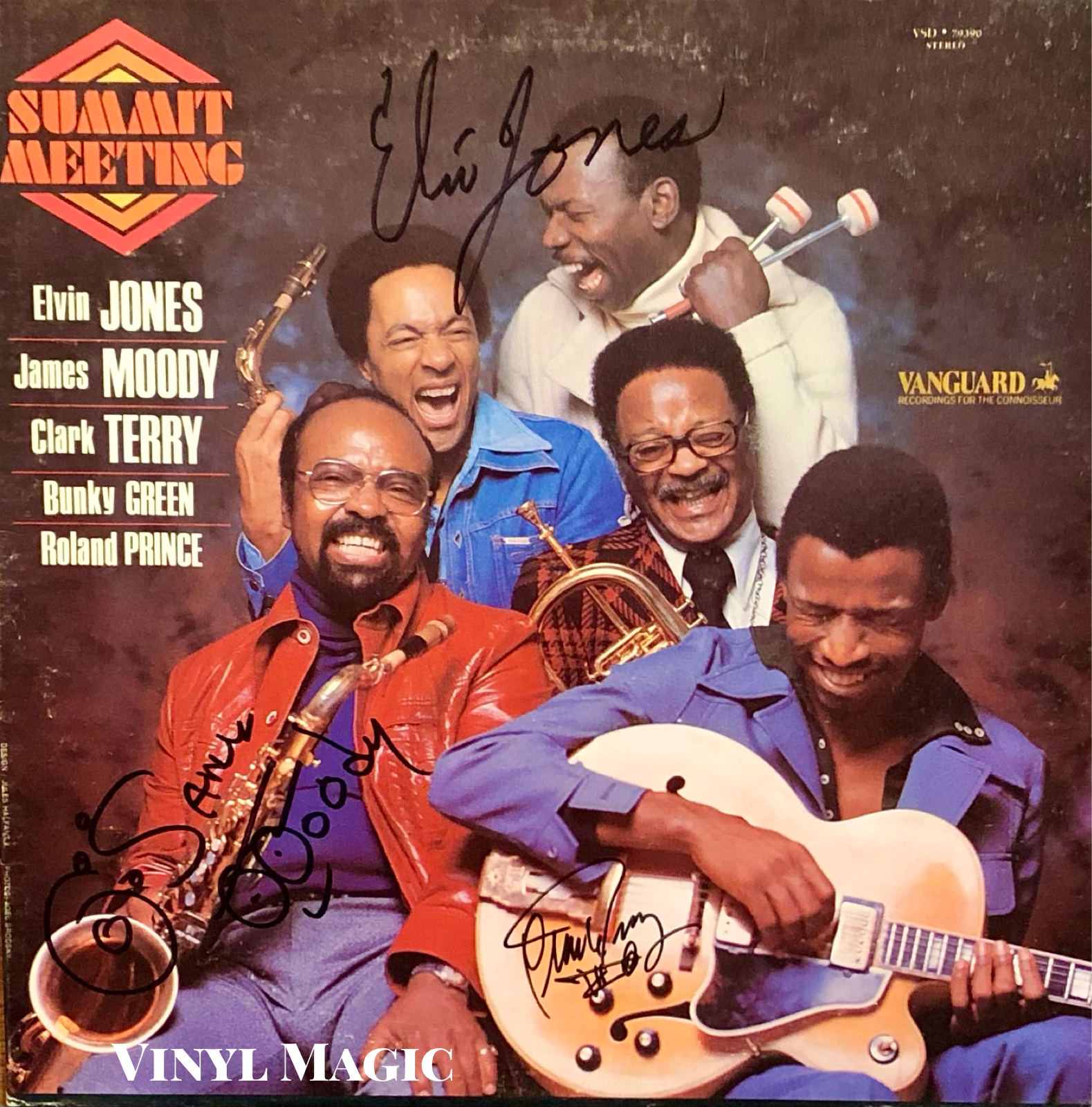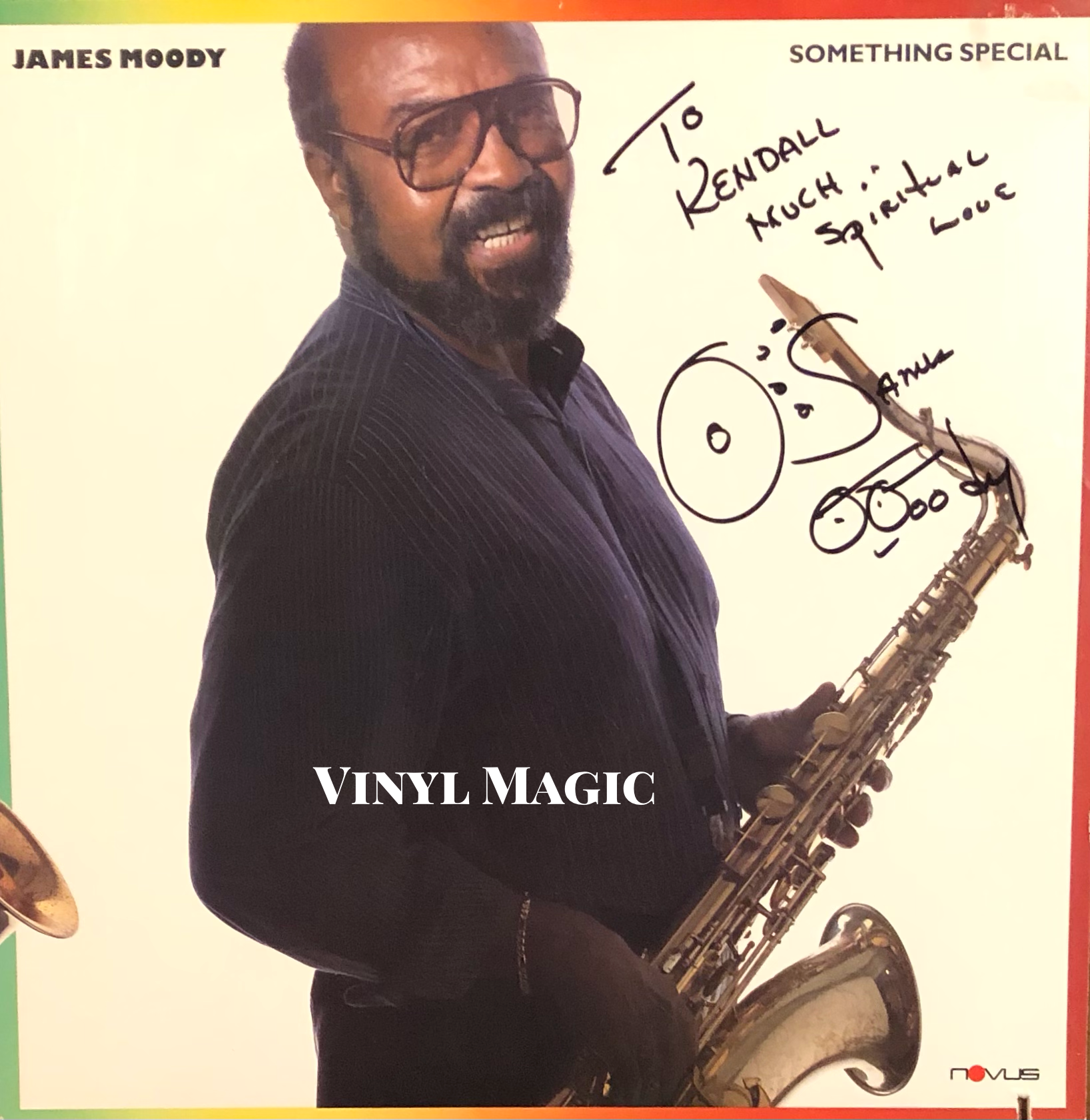James Moody and Me…
Jazz is a spiritual music.
James Moody
Last Train From Overbrook (1958) signed by Moody
I remember saying to Diz one time, ‘I wish I would have gone to school and studied music.’ Diz looked at me and said, “Moody, you ain’t dead.” That lightbulb went on. I immediately went and bought some music books.
James Moody
Dizzy Gillespie Big Band (circa 1946-1948) signed by Moody, Ray Brown photo by William Gottlieb
The first night I was there, Thelonious Monk was the piano player, Ray Brown, Kenny Clarke and Milt Jackson were in the band. Clark Monroe, the manager, was a Negro, so he was probably fronting it; he dressed well and took care of business. The club was very small, and it was jammed every night; all the different people I’d heard on the radio — Coleman Hawkins, Artie Shaw, Benny Goodman — would be in the audience. It was a thrill sitting there playing the music. Dave Burns showed me the line of ‘Things To Come’ just before the gig, and I played it. It was a breeze; I could read a little bit, and with time I learned to read more and more.
James Moody on his first gig with Dizzy Gillespie’s 1946 big band
Miles Davis/Tad Dameron (1949 recordings) signed by Moody
The way I came up musically was wrong, I think, from the standpoint that I thought improvising was spontaneous. I was playing by ear, and I thought you just did it; I didn’t realize that you had to practice changes. I started drinking, because people were saying how great I was, and I couldn’t play crap. It’s like I was flying an airplane but I didn’t know what the route was. If you don’t know the changes, you’re skimming. My music thing started changing later, when I started trying to find out about chords and theory.
James Moody
In The Beginning (1949) signed by Moody
Moody started off with a gift, and he developed it. As an ear player, he was already extremely advanced; right now, he’s one of the greatest players who ever lived. I admire his tenacity and focus. If he hears you play a lick or a sequence that he hasn’t heard, he’ll ask you what it is, and once you show it to him, man, Moody takes it into his own style and elaborates on it, turns it inside-out, and does everything possible with that idea to make it his own.
Jimmy Heath on James Moody
Moody With Strings (1951) signed by Moody
I’d been a friend of Moody’s since 1946 when he came to Philadelphia with Dizzy’s band. He’s still with me. We were in the same saxophone section many times and we called each other Section. And we were both indebted to the genius, Mr. Dizzy Gillespie. My whole life in music is dedicated to Dizzy. Moody felt the same way… I liked Moody on all his instruments. I liked him on flute, but at the end of his life he backed away from the flute because it wasn’t classical sounding, like Jean-Pierre Rampal. But it was James Moody on flute, and he had a jazz interpretation that was unique. I wrote a composition for Moody and the lyric tells the whole story. He was one of he most giving people I’ve ever met. He gave me hats, and he gave me dolls that played the saxophone, and mouthpieces and books. And Moody was a loving person to everybody. We went on tours together and you’d meet him at breakfast and he’d give you a kiss on both cheeks. At lunch, another kiss, at dinner, one more. I said he’s got more kisses than Hershey’s. He was all love; a beautiful person. He has a unique sound. When he had his small group after Dizzy, he didn’t know all the changes. Others could tell you every chord in every song. Moody just had a big ear for music. That solo he played on “Emenon” with Dizzy? That’s a classic. But he wanted to learn to play by the changes, so he would ask me and some others who knew the inside of music, because we were writers. He’d say, “Section, show me how you do that.” And I’d show Moody stuff on the diminished chord and he’d play it so fast, I still can’t play it as fast as he could. I showed it to him and he could outplay me on it. He was a person who could grasp anything he wanted. Tom McIntosh also showed Moody how to play by changes. When I wrote “Moody’s Groove,” he liked that.
Jimmy Heath on his friend James Moody, 2011 interview
Brass Figures (1967) signed by Moody, Kenny Barron, Jimmy Owens
An arranger, composer, flautist and saxophonist, James Moody was born in Savannah, Georgia in 1925. Soon, Moody's family moved to New Jersey where he grew up, and he was influenced by the great Count Basie bands of the 1930s and 1940s, and his heroes, Coleman Hawkins and Lester Young. Following his discharge from the military, he joined the Dizzy Gillespie Big Band in 1946-1948 which featured future jazz legends Miles Davis, John Lewis, Ray Brown, Milt Jackson and Kenny Clarke.
James Moody’s Moods (1954) signed by Moody
Moody had his first big hit with "Moody's Mood For Love" in 1952. The melody was lifted out of a saxophone solo Moody did for "I'm In The Mood For Love", a song written in 1935. An early form of sampling, Eddie Jefferson wrote new lyrics: "There I go, there I go, there I go, pretty baby you are the soul who snaps my control...." and voila, a new hit song and jazz standard. In the ensuing years, "Moody's Mood" has been sung by everyone from Aretha Franklin to Barbra Streisand, Van Morrison to Amy Winehouse.
Flute ‘n’ The Blues (1956) signed by Moody
James Moody's career was almost derailed by his alcoholism. Twice. He tried a geographic cure in 1949 when he moved to Paris to live with his uncle. That worked for awhile until it didn't. Unlike many of his jazz peers who succumbed to the ravages of alcoholism and drug addiction, Moody sought help and entered the Overbrook Hospital in Cedar Grove, New Jersey in 1957. Upon his successful treatment and release, he recorded Last Train From Overbrook (1958), which included the title cut, a percussive and locomotive blues. The liner notes (written by Moody's producer, Dave Usher and novelist Frank London Brown) were quite startling. They explicitly mentioned Moody's treatment for alcoholism at Overbrook, not the usual fodder circa 1958 for an African American jazz man. I have read a lot of liner notes over the years, but none like this:
"Jimmy took his first train to Overbrook in April of this year. In talking to him prior to his voluntary commitment, he sounded almost hopelessly drowned in the juice he was hung up with.... Overbrook is a mental institution in Essex County, New Jersey. Behind him stood the clean, quiet buildings of the hospital; behind that stood the awful memory of the alcoholic, sick, confused James Moody of the past...The Last Train From Overbrook is a brief history of how one James Moody, musician wailed....fell...and got up and wailed again."
James Moody (1959) signed by Moody
To his friends and fans, James Moody had no first name, he was just Moody. He was full of life and energy, and he had an indomitable spirit that was infectious. Moody could play alto or tenor saxophone or flute with equal dexterity and proficiency. He was born partially deaf and he had a noticeable lisp or speech impediment. Only Moody didn't think so. He said, "And that's why I sound like I have a lisp. But I don't have a lisp. It's cause I don't hear S's." So he sang "Moody's Mood For Love" at every performance with as much soul and passion as Aretha, or anyone else who ever sang his song.
Cookin’ The Blues (1961) signed by Moody
At Birdland in NYC in the late 1990s after another great performance, Moody was excited when I showed him the Dizzy Gillespie Big Band poster. He grabbed it out of my hands, and took it to show his wife and some friends who were sitting at a nearby table. "Look at me! Look how handsome and young I was!" he exclaimed. A nineteen year old Miles Davis was in the back row, along with other jazz greats like Milt Jackson, John Lewis, Ray Brown and Cecil Payne. And Dizzy was playing a straight horn, not the bent upright horn which he became famous for later in his career.
Great Day (1964) signed by Moody, Hank Jones
I never asked Moody about his recovery from alcoholism. It seemed unnecessary and intrusive. Every Moody performance was uplifting and imbued with his warmth and generous, welcoming spirit. Moody signed every album "much spiritual love” and he meant and lived every word. Jimmy Heath once said, "He was one of the most giving human beings. Everybody who knew Moody knew he was a beautiful person."
Thanks Moody. Much spiritual love indeed.
Comin’ On Strong (1963) signed by Moody
Mood To Be Wooed (1967) signed by Moody
The Blues And Other Colors (1969) signed by Moody, Kenny Barron
Never Again (1972) signed by Moody
Heritage Hum (1972) signed by Moody
Choice James Moody Cuts (per BKs request)
https://www.youtube.com/watch?v=028UoUkO7zc
“Last Train From Overbrook” Last Train From Overbrook 1957
https://www.youtube.com/watch?v=Oe49P8u0nEk
“Moody’s Mood For Love” Live at Montreux 2000
https://www.youtube.com/watch?v=TaewAoFmy_4
“Stardust” Moody’s Mood For Love 1957
https://www.youtube.com/watch?v=t0LQjdAnFWM
“One Note Samba” live with Dizzy Gillespie 1965
https://www.youtube.com/watch?v=zwnkrcIn1VE
”Parker’s Mood” live at Carnegie Hall
https://www.youtube.com/watch?v=H4hjSJcPf90
Mmm..Hmm” live with Dizzy Gillespie 1965
https://www.youtube.com/watch?v=nW4SMTOOiWk
”Giant Steps” live at IAJE 1987
https://www.youtube.com/watch?v=8i6upMImKn4
”Giant Steps” live with Tito Puente 1993
https://www.youtube.com/watch?v=d8NoQ1Txiv0
”Over The Rainbow” Swedish All Stars Greatest Hits 1993
https://www.youtube.com/watch?v=liHZA3_w1dk&list=RDEMYCqCslXnlr5k0gkhw-19rg&start_radio=1
”The World Is A Ghetto” Sax & Flute Man 1973
Sax & Flute Man (1973);signed by Moody
Summit Meeting (1975) signed by Moody, Elvin Jones, Clark Terry
James Moody’s Moods (1968) signed by Moody
Something Special (1986) signed by Moody




















